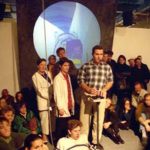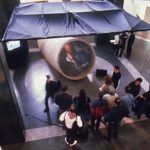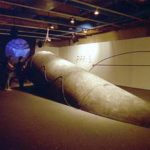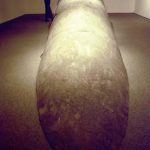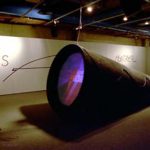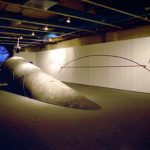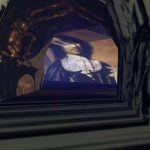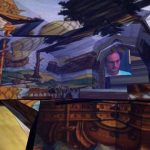The Tunnel under the Atlantic
VR, generated real-time graphics, video and audio online communication, interactive music
A televirtual event by Maurice Benayoun,
Musical creation by Martin Matalon
linking the Pompidou center (Paris) and the Museum of Contemporary Art of Montréal – September 19 – 24, 1995
images of the Tunnel and the ‘diggers’ in Montreal and Paris, snapshots of the virtual tunnel,
Sample video of the actual digging in 1995. Video generated by the artwork
download full presentation documents and press clipping
December 1995.
The Tunnel Under the Atlantic, a televirtual art installation, established a link between Montreal and Paris, two towns physically distant by thousands of miles.
The Tunnel enabled hundreds of people from both sides to meet. From each side, a two-meter-diameter tube, made us think of a linear crossing of our planet as if it were dug under the ground, shouting up in the middle of the Contemporary Art Museum in Montreal on one side, and in the lower floor of the Pompidou Centre in Paris.
The route that lies between the two spots is no simulation of the ocean underground, it is a block of symbolic matter in which the geological strata leave the place to iconographic strata. They are layers of pictures taken in the history of the two cultures that everybody can reveal each time they dig. The collective exploration uncovers fragments of rare or familiar pictures, which are as may opportunities to wake up the collective memory of the participants. Helping us to loiter and talking to people, these remains transform everybody’s digging route into a unique experience, into a personal assemblage made up of sounds and pictures amidst a three-dimensional space architectured through their moves. While digging, the visitors can talk with their partners across the Atlantic Ocean. The sounds of their voices are anchored in space and they enable everyone to find out the directions where to meet the other. It takes six days to built and pave the symbolic space before the face-to-face meeting of both sides diggers.
Free from the physics constraints, Space then is a function of Time. There, speed is not the best way to speed up the meeting, but a way of specifying everyone’s position within the information. The Tunnel’s architecture created by each visitor determines the editing of the picture at the very time of their moves, and inside the freshly built space.
Altered and shaped by the newly dug tunnel, the revealed images conjure up the very matter of scenery that redefines itself as the aftermath of each explorer’s/visitor’s decision. Their sequencing in Time and assemblage in Space are neither merely elements of predetermination nor elements of randomization. Through the things, they deal with, and through the selected images, both come from each visitor’s own way of digging, If we cannot master what we are going to discover, what we find out depends on our own way of doing things. If we let ourselves enjoy the tantalizing immediate feeling of the euphoric capacity of digging at high speed, we do not come across the same iconographic remains as the ones we can see when exploring the discovered elements carefully and curiously. Everybody’s interest in some details in the documents accounts for the theme and the semantic developments that will come afterward. The writing process then does not concerns a definitely established building up of sounds and pictures any longer but does concern the creation of their appearance conditions thanks to the visitors’ exploratory behavior.
The combination of chance and determination which defines the resulting architecture makes the world-to-explore similar to our current experience of life. The “Gadevu”, the agent developed in a basic version for the Tunnel under the Atlantic has become the Z-A Profiler we can use for the dynamic and intuitive exploration of complex databases. Combining the spontaneous actions and dialogues, the music composed by Martin Matalon alters in the course of the event and is organized around personal routes, as it is the case with the pictures then revealed.
The televirtual event -i.e. a remote connection of people in an interactive symbolic space- is filmed with four virtual cameras. What they get is automatically mixed and edited and that takes into account each participant’s speech. They can discover, in the event of a counter-shot, their own live pictures floating within the space they have just dug up. They will not be able to see each other before the two sides of the tunnel meet. The exchange is essentially made up of sounds so far, then becomes visual. When the meeting is achieved, other persons can, at last, take the same way or create new ones as if they were in a collective quest of shared memory.
Maurice Benayoun 1995-2003
the Tunnel under the Atlantic
Directed by: Maurice Benayoun
Musical creation: Martin Matalon
Musical assistants : Xavier Chabot, Frédéric Voisin & Xavier Bordelais (IRCAM)Press relations : Karen Benarrouch (Z.A Production)Produced by : Stéphane Singier (Z.A Production)
Software and engineering: David Nahon & Tristan Lorach (Z-A Production)
Stage Manager : Michèle Ange Coumau (Z.A Production)
PRODUCTION :
France : Z.A production Paris France
E-mail : maurice benayoun
Canada : Zone production Montreal Canada
the Tunnel under the Atlantic is :
A Délégation aux Arts Plastiques, Ministère de la Culture public order (France).
Coproduction : Z.A Production / IRCAM / Mission Recherche et Technologies du Ministère de la Culture / Centre Georges Pompidou.
Thanks to Ministère canadien du Patrimoine – Musée Canadien des Civilisations de Hull – Réunion des Musées Nationaux – Silicon Graphics France et Europe (SGI) – Canon France.
An ISEA 95, Montreal common project.
WEB adresses :
IRCAM – Ministère de la culture







